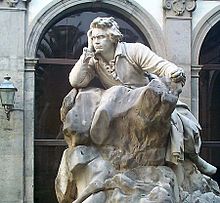- Music conservatories of Naples
-
Music of Italy Genres: Classical (Opera) - Pop - Rock (Hardcore - New Wave - Progressive rock) - Disco - Folk - Hip hop - Jazz History and Timeline Awards Italian Music Awards Charts Federation of the Italian Music Industry Festivals Sanremo Music Festival - Umbria Jazz Festival - Ravello Festival - Festival dei Due Mondi - Festivalbar Media Music media in Italy National anthem Il Canto degli Italiani Regional scenes Aosta Valley - Abruzzo - Basilicata - Calabria - Campania - Emilia-Romagna - Florence - Friuli-Venezia Giulia - Genoa - Latium - Liguria - Lombardy - Marche - Milan - Molise - Naples - Piedmont - Puglia - Rome - Sardinia - Sicily - Trentino-Alto Adige/Südtirol - Tuscany - Umbria - Veneto - Venice Related topics Opera houses - Music conservatories - Terminology The Music Conservatory of Naples is a music institution in Naples, southern Italy. It is currently located in the complex of San Pietro a Majella.
Contents
San Pietro a Majella
The conservatory and adjacent church are today part of the old San Pietro a Majella monastic complex, built at the end of the 13th century and dedicated to the monk Pietro da Morone, who became Pope Celestine V in 1294. The conservatory houses an impressive library of manuscripts pertaining to the lives and musical production of composers who lived and worked in Naples, among whom are Alessandro Scarlatti, Pergolesi, Domenico Cimarosa, Rossini, Bellini, and Donizetti. Vittorio Monti, who around 1904 composed the famous Csárdás, studied violin and composition at this conservatory. The historical museum has a display of rare antique musical instruments.
The historic conservatories
San Pietro a Majella is actually the last in a long string of establishments that have been music conservatories in Naples. Their existence goes back to the Spanish rule of the city as a vicerealm starting in the early 16th century. These early conservatories were Santa Maria di Loreto, Pietà dei Turchini, Sant'Onofrio a Capuana, and I Poveri di Gesù Cristo. They enjoyed a considerable reputation as training grounds not only for young children to be trained in church music, but, eventually, as a feeder system into the world of commercial music once that opened up in the early 17th century.
Conservatorio della Pietà dei Turchini
That Conservatorio della Pietà dei Turchini was built in 1583 and is the only one of the original four sites that is still easy to find. Indeed, the church is still prominent and open to the faithful. It stands on via Medina not far from the city hall. The church has a historical marker posted in front that explains its role as one of the original four. The name "conservatory" originally indicated a place that "conserved" orphans and young women. All of the institutions instructed their wards in music; thus was born the modern meaning of "music school."
Conservatorio dei Poveri di Gesù Cristo
The Conservatorio dei Poveri di Gesù Cristo was founded in 1589 by Marcello Fossataro, a Franciscan monk. It was adjacent to the church of Santa Maria a Colonna on via dei Tribunale. Illustrious names connected with the school include the philosopher Giovan Battista Vico; a "maestro de [sic] grammatica" from 1620 to 1627. Musical luminaries at the conservatory included Francesco Durante, Nicola Porpora, and Giovanni Battista Pergolesi.
Santa Maria di Loreto
Santa Maria di Loreto was built in 1537 and was the original conservatory in Naples, coming at the beginning of the Spanish expansion of Naples under the city's most famous viceroy, don Pedro de Toledo. It is the first secular music conservatory.[1] This academy counts as its alumni Domenico Cimarosa. Old maps show Santa Maria di Loreto to have been a seafront "borgo" —a separate section of town. Thus, the conservatory was beyond the Spanish fortifications that guarded the southeastern approach to Naples.
Sant'Onofrio a Capuana
Sant'Onofrio a Capuana dates from 1578 and counts as its alumni Niccoló Jommelli, Giovanni Paisiello, Niccoló Piccinni, and Antonio Sacchini, four of the great names in the 18th century Neapolitan music. The Italian Baroque composer Cristofaro Caresana was a director from 1667 until 1690. The original building still stands, just across the street on the north side of the old Vicaria, the tribunale, the Naples Hall of Justice.
San Sebastiano
In 1806, with Napoleon Bonaparte's brother, Joseph, installed as the king of Naples in what would be a decade of French rule of the kingdom, monastic life in the kingdom was drastically reorganized and the four monastery music schools were consolidated into a single building, the Church of San Sebastiano, not far from the modern conservatory. Finally, in 1826 that consolidated conservatory was moved to the present site.
References
- di Giacomo, Salvatore (1924). I quattro antichi conservatori di musica a Napoli (The Four Ancient Music Conservatories of Naples). Milan: Sandron.
- Florimo, Francesco (1882). La scuola musicale di Napoli e i suoi conservatori, con uno sguardo sulla storia della musica in Italia (The Music School and Conservatories in Naples, with a look at the musical history of Italy). Four volumes.. Napoli: Morano.
External links
Categories:- Culture in Naples
- Music schools in Italy
Wikimedia Foundation. 2010.

